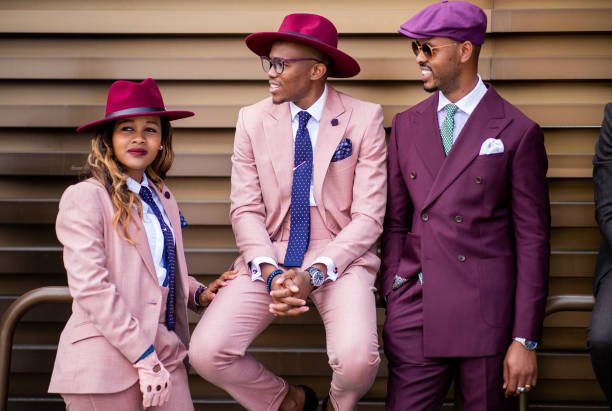Threads Of Expression: When La Sape and Pitti Umo walk the same runway.
- LuvPrize Lounge

- May 5
- 3 min read

Twice a year, Florence transforms into a living gallery of men's fashion as Pitti Uomo unfolds its spectacle of color, creativity, and charisma. Across the globe, in the vibrant streets of Brazzaville and Kinshasa, a different yet strikingly resonant sartorial tradition lives on—La Sape, the art of elegant living. Though they were born in different worlds, the energy of Pitti's Peacocks and the legacy of Congo's Sapeurs share a common thread: the power of fashion to tell stories, shape identity, and uplift the spirit.

The Story of La Sape: La Sape (Société des Ambianceurs et des Personnes Élégantes) is not merely a fashion movement—it’s a philosophy. Emerging in the early 20th century as a creative response to colonial influence, Congolese men turned European fashion into a tool for resistance, pride, and personal dignity. La Sapeurs dress with intention, their outfits broadcasting elegance, discipline, and cultural pride—even in the face of hardship. It is a celebration of self-worth stitched in color, texture, and tradition.
The Brilliance of Pitti Uomo: Pitti Uomo, launched in 1972, is the heartbeat of global menswear innovation. It champions not only fine tailoring but individual expression. The men photographed outside the shows—the so-called "Pitti Peacocks"—have become symbols of self-confidence and sartorial joy. They showcase a modern masculinity that embraces flair and creativity, proving that fashion can be both artful and powerful.


“The peacock, the very symbol of Pitti flair, is also the national bird of the Congo.”

What’s even more inspiring is the increasing presence of women in La Sape & Pitti Uomo. From bold power suits to playful couture-streetwear hybrids, women are carving their own space within a traditionally male-focused event. Their fearless style and elegance contribute to the evolving diversity of Pitti's aesthetic, proving that elegance and self-expression know no gender. Their participation not only reflects changing attitudes in fashion but also mirrors the inclusivity and pride celebrated in La Sape’s philosophy.
A Shared Language of Elegance: Though born in vastly different contexts, Sapeurs and Pitti Peacocks speak the same style dialect. Bold patterns, sharp tailoring, layered textures, and an unmistakable presence—both celebrate fashion as a form of personal and cultural storytelling. While one evolved from resilience and the other from revelry, both uplift the wearer and captivate the world.

Voices from the Movement:
To celebrate the harmony between these two fashion cultures, we highlight voices from La Sape who speak to the heart of dressing with purpose:
Papa Wemba, musician: “White people invented the clothes, but we make an art of it.”

Maxime Pivot Mabanza, teacher and Sapeur: “Being a Sapeur is about attitude... telling the world I am still human.”
Charlie Schengen, London Sapeur: “La Sape can drive you crazy. But if you feel it, you do it big.”
Cedrick Golden, London Sapeur: “La Sape gives you courage to wake up in the morning.”
Yaya Beauga, artist: “When I dress in suits, I think of my father and his classic style.”
Theophile Munganga, fashion lover: “Designer garments made me feel proud.”
Messani Grace, Sapeuse: “My husband supports me in my fashion journey.”
Victoire Douniama, photojournalist: “La Sape began as protest. Now it stands for freedom of expression.”

"La Sape" (2020) is a short documentary film that offers an intimate glimpse into the vibrant world of Congolese dandyism. Directed by Matarrese and Lamouri, the film explores the lives of Sapeurs- members of the Société des Ambianceurs et des Personnes Élégantes- as they navigate their everyday realities in stark contrast to their flamboyant, elegant style. Through striking visuals and personal testimonies, the film captures the heart of La Sape not just as fashion, but as cultural resistance, self-affirmation, and a philosophy of dignity and hope. It highlights how style becomes a tool for survival and self-expression in the face of adversity, bringing global attention to a movement rooted deeply in African identity and pride.
Walking the Same Path in Style
La Sape and Pitti Uomo are not competing visions—they are complementary celebrations of style. Each in their own way, they honor the human desire to be seen, respected, and admired. Whether in Florence, Brazzaville or Kinshasa, these movements remind us that fashion, at its best, is more than trend—it’s tradition, transformation, and triumph. May we see their reflections not as echoes of the past or rivals in the present, but as partners in the same elegant dance of self-expression.



























Comments